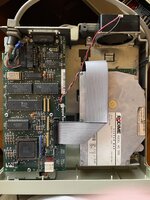Update: I scored an HD20! Nonworking but in great cosmetic condition, ripe for a TashTwenty control board replacement.
More interesting update:
I decided to put the scope on the Classic II with my proven-to-work TashTwenty dongle thing. As expected, it didn't work. Unexpected, however, was the fact that it appears not to work not because the CII is failing to detect it, but because the firmware thinks the SD card has no partitions and so isn't responding. !ENBL goes low and the daisy-chain !ENBL output immediately goes low. Exact same board, exact same setup consistently works fine on my 512ke.
This is
really interesting. Maybe it's something with the Classic II in general? With my particular Classic II? Something to do with power? A firmware bug triggered by some difference in behavior in the Classic II's ROM? I don't know. All I know is, I really want to get this into more people's hands, ideally people with access to a IIsi, IIci, Classic II, or one of the other setups where HD20 is supported on a machine faster than 8 MHz.
The total BOM needed to build one of my TashTwenty boards is:
I have some parts on hand which I'm prepared to sell at cost (or at least my best guess at it), I believe I have enough to make:
If you want to buy one, let me know. Shipping not included - I'm in the US - if you're in the EU, you're probably better off buying one of
@demik 's, shipping in either direction is absurdly expensive. If you do buy one of mine,
nota bene and be comfortable with the usual caveats: these are unassembled kits provided without guarantees or warranties, no returns, satisfaction not guaranteed, you should know what you're doing.

